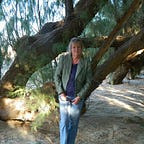Science Says: “About Covid, We’re learning as we go.”
And Why That’s Not Good Enough for Some of Us. . .
I won’t go into the particulars of writing about a pandemic. You try to get things right, or close to right. Most of what you instinctively feel about a world-wide deadly epidemic is objective. At least in 2005. You know there’s terrible, maiming, blood-gushing disease in limited quantities, and most of it resides in other countries, not your own. You tell yourself you can dig into the truth with the aid of science and a bit of wisdom from the experts. You ally yourself with National Geographic and Smithsonian articles and the magnificent The Great Influenza, and it seems thorough enough. They are all good resources to write a novel in 2005 to 2008. Because they’re looking back in time and constructing what they have struggled to obtain — the truth.
Fast forward to the actual unfolding of a pandemic. One not as deadly as the one you wrote about, but numbers are adding up fast. There is a believable trajectory — a coronavirus comes through a crack in time and its invasion is slow but sure. Confusion causes delay in developing a plan. A virus, being one of the non-thinking success stories of all time, moves into rhythm with its ancestry and begins threading through humanity in deadly abandon. I say to myself, “Aha, now I’ll finally understand. Science has got this.”
But here’s the rub. Science doesn’t have this, because science didn’t expect this. They knew, and I mean they really knew a pandemic was coming. But they didn’t know which one. They were into gene-splicing vaccines well before I began researching those Natl Geo articles, and they had been on pandemic alert at least since the SARS-CoV outbreak in 2003. But they were planning, in large brushstrokes, for a human-animal pandemic, specifically a bird flu pandemic, in large part because it seemed the most likely. And it still does.
I don’t spend a lot of time watching the CDC, verifying numbers, extrapolating data to support my thoughts. The time for that was when I was writing a book almost 20 years ago. But I do think about the relevance of comparisons. I’ve re-read what I read then and am mystified by what science knew and what science readily admitted they didn’t know. How they began to build a grid of disease networking that despite the variances in viruses would take us into a new age of vaccines while at the same time quietly stating, “Part of science is to do things in blinded fashion.” Science had to prepare on the widest palette imaginable the surest methods to subdue viruses, all of them, because there was no clue as to which one would touch off a catastrophe.
So in 2020 it just happened to be a coronavirus. In 2003, Smithsonian carried an article in which coronaviruses were described, as it turns out, quite prophetically. “What scientists do know about coronaviruses in general, and SARS-CoV in particular, suggests that infection may differ considerably from victim to victim, persist over time and be difficult to vaccinate against. . . The capacity to form “recombinants,” or hybrids, as well as the virus’s large genome, enable the genus to easily gain or lose traits. Such traits may include the ability to infect new species, elude the immune system and change residence in the body over time.”
Knowing all that, we’re now at the point of taking that much-explained, mega-verified Covid vaccine, and I’m not saying it’s a bad thing. For some, it may be the equivalent of life saving, if only in a mental sense. But what I see as a writer of a pandemic before there was one depends on point of view. And right now that point of view is bravely being worn by science. The science that tells us it is learning as we go, the science that prepared for everything before preparing for a known something, the science that recognizes overall predictions of a virus don’t necessarily unfold as expected. That same Smithsonian article also noted: “Coronaviruses are changelings, multitaskers, rule breakers.”
It is that last sentence that will go into the future with me — -as a writer, as an intuitive woman and maybe a bit of a rule breaker myself. Perhaps that explains why I understand the man or woman who questions the authority of science, at least in this current situation. Because, like them, I realize science deals in risk — in this case, management of disease risk. It is the job of science to get it right. It is the authority they seek and claim.
I’m old enough to remember when science told us animals, all animals, felt no emotion. They gave various reasons why, and the biggest was authority. I started doubting science way back then.
Sources: National Geographic, Vol. 208, №4, October 2005, “Tracking the Next Killer Flu,” Tim Appenzeller
Smithsonian, September 2003: “Stopping a Scourge” (Presence of Mind), David Brown
Quote: Sherif Zaki, then (2003) chief of infectious disease pathology at the CDC (Smithsonian article)
